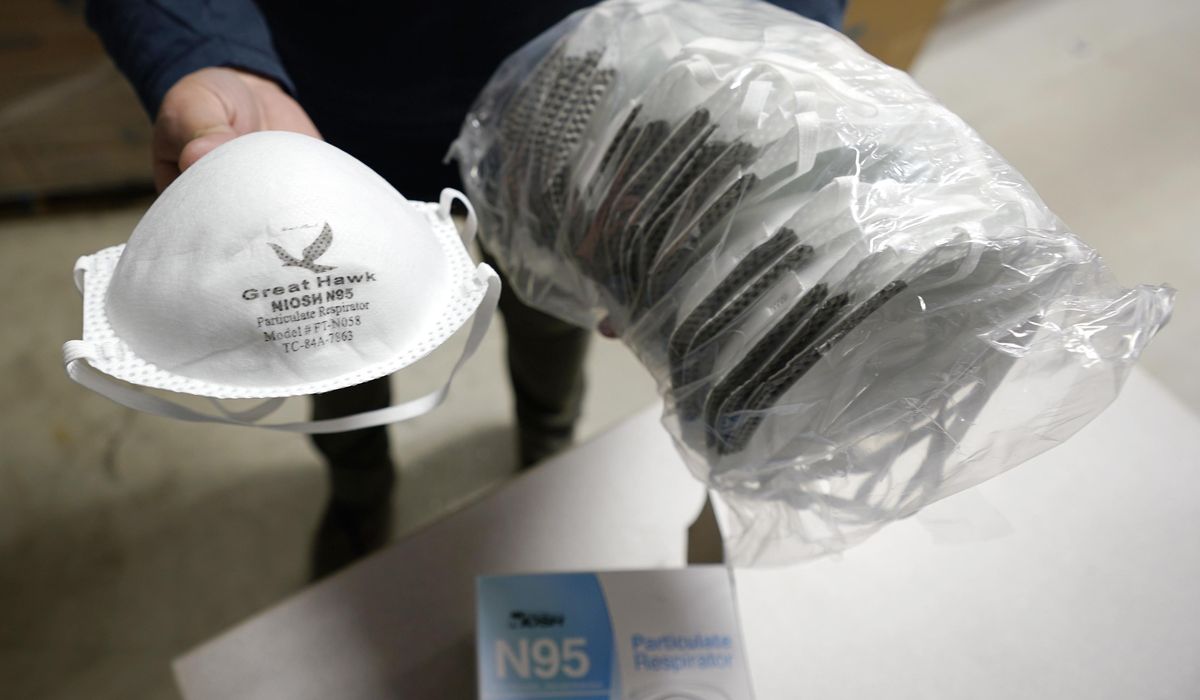
Your cotton Hello Kitty mask is no longer going to cut it, and Sen. Rand Paul isn’t the only one saying so.
Six months after the Kentucky Republican was suspended on YouTube for ripping cloth masks, a rising chorus of medical experts is urging Americans to upgrade their facial coverings as the highly contagious omicron variant drives coronavirus daily case counts to record U.S. highs.
“Cloth masks aren’t going to provide a lot of protection — that’s the bottom line. This is an airborne illness,” former Food and Drug Administration Commissioner Scott Gottlieb said on CBS’ “Face the Nation.” “We now understand that, and a cloth mask is not going to protect you from a virus that spreads through airborne transmission.”
Even more adamant was Dr. Leana Wen, a visiting professor at the George Washington University Milken Institute School of Public Health and an emergency room physician, who decried fabric facial coverings as practically useless.
“Cloth masks are little more than facial decorations,” Dr. Wen said last month on CNN. “There’s no place for them in light of omicron.”
What to wear instead? Dr. Wen recommended donning at a minimum a three-ply surgical mask — the disposable variety widely sold by the boxful — but better still are the respirators, starting with the gold standard, the N95.
“We’ve known for a while that wearing face masks can block the exhale of virus particles into the air around you, which helps keep the virus from spreading. And, of course, masks are also a helpful barrier when you cough or sneeze,” the Cleveland Clinic said in a Dec. 28 post. “But cloth masks, which are often made of materials like cotton, don’t do much to protect you from inhaling particles that carry the virus — and with a virus as infectious as omicron, that becomes a problem.”
In addition to the N95, the clinic recommended the KN95 (regulated by the Chinese government), and the KF94 (regulated by South Korea), but warned that about 60% of the KN95 respirators are counterfeit. The Centers for Disease Control and Prevention keeps an updated list of recommended brands.
“It’s really best to find a mask that has been approved by a regulating body,” said Dr. Stephen Gordon, an infectious disease specialist at the Cleveland Clinic. “But the truth is that at the end of the day, any mask that fits closely to the face is better than a mask that doesn’t.”
At this stage of the pandemic, cloth masks don’t provide much protection against COVID-19, according to @ScottGottliebMD. pic.twitter.com/pvX5McVnzX
— Face The Nation (@FaceTheNation) January 2, 2022
A major advantage of the surgical masks and respirators is that they are made with melt-blown polypropylene, which helps trap the airborne particles.
Dr. Abraar Karan, a Stanford infectious diseases specialist and longtime advocate for high-filtration masks, said the material forms “this complex sort of webbing, which is then electrostatically charged, and that pulls the particles in when you’re inhaling and exhaling.”
“Cloth masks are often just woven thread and other materials that don’t have that design,” Dr. Karan told New York magazine in a Dec. 30 interview. “Cloth masks don’t provide great source control, either. The CDC is now letting people who test positive for COVID-19 stop isolating after five days and then wear a mask for five days. It would have been ideal for them to also recommend that [they wear] a better mask.”
Indeed, the CDC still recommends choosing masks with “two or more layers of washable, breathable fabric” in its latest guidance updated Oct. 25.
White House chief medical adviser Anthony Fauci said Sunday that surgical masks and even cotton masks are effective in preventing the spread of the omicron variant.
“Are they as effective as an N95? No,” Dr. Fauci said on CNN. “But what was being said is rather wear a cotton or a surgical mask than not wear any mask at all. And that’s the point that was made.”
“They have a degree of effectiveness. And if that’s the mask that’s available to you, use it,” he said.
Dr. Fauci and Mr. Paul, a physician, have feuded over masks and other pandemic-related issues. In August, a video in which Mr. Paul criticized the effectiveness of cloth masks was removed from YouTube and his account was suspended.
“Here’s the thing: What I said in that video is actual science,” Mr. Paul said in an August video post on Rumble. “Most of the masks you get over the counter don’t work. They don’t prevent infection. Saying cloth masks work when they don’t actually risk lives, as someone may choose to care for a loved one with COVID while only wearing a cloth mask.”
Mr. Paul, who refused to wear a mask in the Senate after recovering last year from COVID-19, added that “when it comes to N95 masks, I’ve always said that those do work.”
Even without a CDC recommendation, the move to high-filtration masks is well underway. In Connecticut, Gov. Ned Lamont announced last month plans to distribute 6 million N95 masks to residents.
“Given the highly infectious nature of the omicron variant, it is most important to wear any mask both in public spaces and when interacting in close contact with individuals outside of your household, but an N95 mask will provide better protection,” Dr. Manisha Juthani, state public health commissioner, said in a Dec. 29 statement.
The White House has begun requiring the N95. The White House Correspondents Association asked reporters in a Dec. 19 email to upgrade their masks.
“A reminder: If you must come into the White House, we ask that you please wear either an N95 or KN95 mask and avoid using cloth or surgical face coverings that do not provide a complete seal of your nose and mouth,” the message said.
The White House now requires those who interact with President Biden and Vice President Kamala Harris to wear the N95, Politico reported, citing the administration’s internal COVID-19 protocols.
Capitol Hill is also embracing the respirator. The Office of the Attending Physician urged lawmakers in a Dear Colleague letter Monday to return to “maximal telework” after COVID-19 cases jumped from less than 1% to 13%.
“Blue surgical masks, cloth face masks and gaiter masks must be replaced by the more protective KN95 or N95 masks,” Capitol physician Brian Monahan said in the memo, according to media reports.
Meanwhile, the CDC has never recommended the N95 for the general public. Early in the pandemic, Dr. Fauci advised against mask-wearing for fear of shortages. He changed his recommendation months later.
“Now we have masks, and we know that you don’t need an N95 if you’re an ordinary person in the street,” Dr. Fauci told TheStreet in a June 2020 interview. “We also know that simple cloth coverings that many people have can work as well as a mask in many cases.”
Dr. Rochelle Walensky, director of the Centers for Disease Control and Prevention, said in January 2021 that members of the general public should not use the N95, citing the difficulty of wearing them.
“I have spent a reasonable amount of time in an N95 mask. They’re hard to tolerate all day every day,” Dr. Walensky said. “And in fact, when you really think about how well people will wear them, I worry that if, if we suggest or require that people wear an N95, they won’t wear them all the time.”
Dr. Karan said the concern about comfort was “one (of the many) excuses for why N95 and other respirators were not prioritized for scale-up with [the] Defense Production Act last year for the protection of the public.”
“It’s far less comfortable getting #covid19 and potentially infecting your family,” Dr. Karan said in a Dec. 23 tweet.
The omicron variant is behind a huge COVID-19 spike over the last several weeks, with U.S. case counts topping 1 million on Monday, according to the Johns Hopkins University Coronavirus Resource Center.
Death rates, however, are not rising with the case counts, and many front-line medical personnel report that the variant, while highly contagious, seems less deadly and with milder symptoms than earlier strains.
• Jeff Mordock contributed to this report.
For more information, visit The Washington Times COVID-19 resource page.








